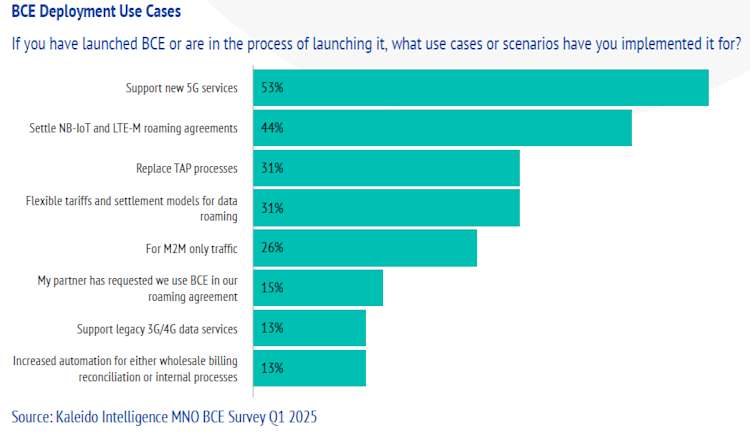The latest report from Kaleido Intelligence focuses on “BCE & the Future of Wholesale Roaming.” This report, Sponsored by Syniverse, explores decision drivers and use cases for BCE adoption and culminates in a webinar featuring an expert panel discussion. Here’s a glimpse at the critical factors shaping BCE adoption.
What’s driving the need for a clearing standard in the mobile industry?
The mobile industry is continuing to shift towards automated and multi-party ecosystems that take advantage of cloud opportunities through the growth of large-scale data centers and data management services. This is leading mobile network operators (MNOs), mobile virtual network operators (MVNOs), IoT platforms, and enterprises to focus on implementing billing solutions that help support interoperable, modular, and scalable models. To better equip MNOs and enterprises for this industry shift, a new standard was developed to provide a more flexible, transparent, and cost-efficient approach to billing and charging in the telecom ecosystem.
The new standard, Billing and Charging Evolution (BCE) is a GSMA-compliant configuration for exchanging usage, commercial, and settlement data, enabling partners to work from a common framework, simplifying integration and lowering costs. As diverse charging models increasingly become more dynamic and services more granular, BCE ensures accuracy, reduces billing disputes, and supports faster revenue recognition.
How did BCE evolve from legacy clearing systems?
While the traditional Transferred Account Procedure (TAP) has served the industry for decades, its limitations in being able to support next-generation applications and charging models continue to put the limelight on BCE. The BCE standard was developed upon requests from MNOs who intend to launch and monetize data-based high volume, low margin services. Through standardized interfaces and reports, real-time charging capabilities, and flexible billing models — leveraging technologies like blockchain for secure and transparent data exchange — BCE can support the aggregation of data and wholesale reconciliation, giving MNOs the opportunity to make money on services that are currently unmonetized or have limited financial value.
To further support the shift towards BCE, operator motivations for migrating from TAP are strongly aligned with the evolving needs of the roaming ecosystem. The primary drivers include the need to support more flexible and innovative commercial models in wholesale billing (68%) and the ability to monetize new services such as 5G roaming (67%) and IoT traffic (65%).1
Where does BCE stand in the telecom ecosystem right now?
BCE is revolutionizing the telecom ecosystem by offering a more flexible and efficient billing system. It supports diverse charging models, including real-time and service-based billing, particularly crucial for 5G and IoT networks. Newcomers to the industry, like satellite operators, are also keen to use many different flexible charging methods to transform the ecosystem. The dynamic pricing available in BCE makes it a vital tool to drive new revenue streams.
BCE's ability to streamline processes and automate much of the existing settlement process, enables use cases such as moving all data traffic originally on TAP to take advantage of the benefits needed to support today’s ecosystem. Additionally, BCE is proving a perfect method to bill existing traffic from enterprises that were outside any billing method, demonstrating that BCE can enhance partner experiences.

How does BCE expand current and future use cases?
BCE expands the scope of possible use cases in mobile communications by providing a future-proof and flexible structure for charging and settlement. Unlike legacy billing systems, such as TAP, BCE alleviates many of the charging constraints, enabling MNOs to move beyond simple volume-based billing. This means monetization is possible for differentiated Quality of Service (QoS) levels, application-specific charging, and network slicing within the expanded opportunities of 5G, opening doors for modified services supporting enterprise applications. For example, a critical IoT application requiring low latency can be charged differently than regular data traffic. 5G's expanded capabilities can be offered with tiered pricing based on speed or data allowances.
BCE also facilitates new and advanced roaming agreements that support more complex roaming scenarios, such as service usage, while traveling into globally based networks. BCE empowers MNOs to create and bill for a diverse range of services that were previously impractical or impossible to achieve on older charging mechanisms and the constraints within the TAP standard. BCE is fostering innovation and enabling new revenue streams in the evolving mobile ecosystem.

Kaleido Intelligence webinar and report wrap up
As the roaming industry moves towards BCE, it’s critical for MNOs to strategically plan their migration from TAP.
Kaleido Intelligence has developed a comprehensive report "BCE & the Future of Wholesale Roaming," sponsored by Syniverse. This report, based on a survey designed by both Kaleido and Syniverse, is also explored in an exclusive webinar discussing the latest research, followed by an expert panel discussion on the critical factors shaping BCE adoption.
What you’ll learn:
-
Key Findings From Kaleido’s Latest Operator Survey
Explore insights from 75+ MNOs to understand industry trends and perspectives. -
BCE Readiness & Deployment Strategies
Learn how leading operators are preparing for BCE and the critical factors they consider, including investment priorities and technical requirements. -
First-hand Insights from Industry Leaders
Gain valuable perspectives through real-world use cases and best practices for overcoming deployment challenges. -
Live Q&A
Engage with our panel of experts and ask questions to inform your strategy.
Click here to watch the webinar and download the report.
1. Kaleido Intelligence. April 2025. “BCE & The Future of Wholesale Roaming, Unlocking 5G, IoT, and the New Era of Connectivity.” BCE & the Future of Wholesale Roaming | Syniverse




